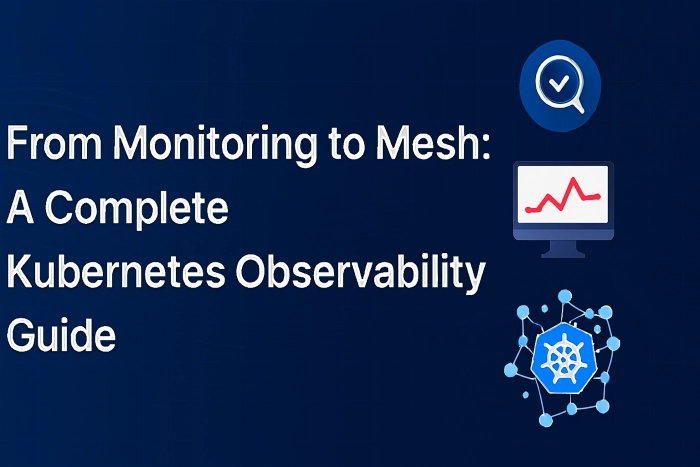
From Monitoring to Mesh: A Complete Kubernetes Observability Guide
In today’s cloud-native era, observability has shifted from a “nice-to-have” to a critical business requirement. A recent CNCF survey revealed that over 96% of organizations are using or evaluating Kubernetes, but nearly 50% report challenges in monitoring and troubleshooting production workloads. These gaps don’t just frustrate DevOps engineers—they directly impact revenue, customer experience, and brand trust. This is where a Kubernetes Observability Guide becomes essential.
By moving beyond basic monitoring and embracing advanced observability practices, businesses can unlock faster issue resolution, reduced downtime, improved compliance, and optimized costs. This blog provides a complete walkthrough—from monitoring foundations to service mesh integration—that can help enterprises strengthen performance, reliability, and security in Kubernetes environments.
Why Observability Matters in Kubernetes
Kubernetes brings agility, scalability, and automation to application deployment. But it also introduces distributed complexity: microservices, ephemeral pods, autoscaling nodes, and multi-cluster topologies. Without observability, teams are essentially flying blind.
The cost of poor observability is high:
- Downtime costs an average of $5,600 per minute (Gartner).
- Customer churn increases significantly when digital services fail.
- Engineering productivity drops due to time spent firefighting instead of innovating.
An effective observability strategy provides end-to-end visibility across metrics, logs, traces, and events. This enables teams to proactively detect anomalies, isolate root causes faster, and continuously improve reliability.
Monitoring vs. Observability: The Shift in Mindset
It’s tempting to treat monitoring and observability as interchangeable, but the difference is significant.
- Monitoring answers: “Is the system healthy?” It uses predefined metrics and dashboards.
- Observability asks: “Why is the system behaving this way?” It focuses on context, correlations, and unknown unknowns.
In Kubernetes, monitoring alone is insufficient because workloads scale dynamically, and failure patterns aren’t always predictable. Observability provides the why behind the what, empowering engineers to make data-driven decisions instead of reactive guesses.
Core Pillars of Kubernetes Observability
A complete Kubernetes Observability Guide should cover these four pillars:
- Metrics
Numerical data points (CPU usage, memory, pod restarts, latency). Metrics highlight trends and thresholds, helping teams anticipate performance bottlenecks. Tools like Prometheus and Grafana are widely adopted for Kubernetes metrics. - Logs
Logs offer event details and error records from pods, nodes, and controllers. Centralized logging solutions like ELK Stack (Elasticsearch, Logstash, Kibana) or Fluentd provide searchable context. - Traces
Distributed tracing maps how a request flows across microservices. This is essential for diagnosing latency or dependency issues. Tools like Jaeger and OpenTelemetry support Kubernetes-native tracing. - Events
Kubernetes emits events (e.g., pod evictions, failed health checks). Integrating events with alerts ensures faster remediation.
Together, these pillars provide a 360-degree view of your Kubernetes workloads.
Moving from Monitoring to Observability in Kubernetes
The transition from simple monitoring to advanced observability requires a structured approach:
- Instrumentation First
Applications must emit telemetry data. Use OpenTelemetry SDKs to standardize data collection across services. - Unified Data Pipeline
Instead of siloed monitoring tools, establish a pipeline where metrics, logs, and traces flow into a single backend. This creates correlations across data types. - Contextual Dashboards
Move beyond “average CPU usage” dashboards. Build context-aware views—such as per-namespace latency or error rates tied to specific deployments. - Intelligent Alerts
Alerts should be actionable, not noisy. Use anomaly detection and SLO-based thresholds (e.g., alert only when error rate >2% for 5 minutes). - Service-Level Objectives (SLOs)
Observability must tie back to business KPIs. For instance, define SLOs around 99.9% uptime or transaction latency under 200ms.
The Role of Service Mesh in Kubernetes Observability
Once observability foundations are in place, service mesh technologies like Istio or Linkerd take visibility to the next level.
A service mesh acts as a transparent layer that intercepts service-to-service communication, enabling:
- Granular traffic metrics without modifying application code.
- Automatic tracing of request paths.
- Policy enforcement for security and compliance.
- Fault injection for chaos engineering and resilience testing.
For example, an e-commerce company running 200+ microservices can use Istio’s telemetry to track latency across checkout, inventory, and payment services. If checkout latency spikes, observability dashboards can pinpoint the exact microservice bottleneck, reducing mean time to resolution (MTTR) from hours to minutes.
Business Value of Kubernetes Observability
Observability is not just a technical enabler—it drives measurable business outcomes:
- Reduced Downtime Costs: Detect and resolve incidents before customers notice.
- Improved Customer Experience: Lower latency and fewer failed transactions improve loyalty and retention.
- Operational Efficiency: Engineering teams spend less time troubleshooting and more time innovating.
- Regulatory Compliance: Full audit trails support industries with strict compliance (finance, healthcare).
- Optimized Cloud Spend: Identify underutilized resources and rightsize workloads.
According to IDC, enterprises that adopt observability best practices see 30–40% improvements in reliability metrics and 20%+ reduction in operational costs.
Building a Future-Proof Kubernetes Observability Strategy
To ensure your observability investment pays off, focus on:
- Standardization: Adopt open standards like OpenTelemetry to avoid vendor lock-in.
- Scalability: Choose platforms that can handle multi-cluster and hybrid environments.
- Automation: Integrate observability with CI/CD pipelines for automated health checks.
- AI-Driven Insights: Use machine learning to detect anomalies and predict failures.
- Team Collaboration: Break silos between DevOps, SREs, and developers by sharing observability insights.
The future of observability is proactive and predictive—moving from “What went wrong?” to “What’s about to go wrong?”
Conclusion
The journey from monitoring to service mesh-powered observability represents a transformation in how organizations manage modern infrastructure. This Kubernetes Observability Guide demonstrates that observability is not just a technical necessity but a business imperative. By combining metrics, logs, traces, events, and service mesh capabilities, enterprises gain full visibility into their Kubernetes workloads, ensuring performance, reliability, and cost efficiency.
In a competitive landscape where downtime equals lost revenue, investing in observability is one of the smartest moves technology leaders can make. Organizations that master Kubernetes observability will not only resolve issues faster but will also deliver better digital experiences, protect revenue, and future-proof their infrastructure.

